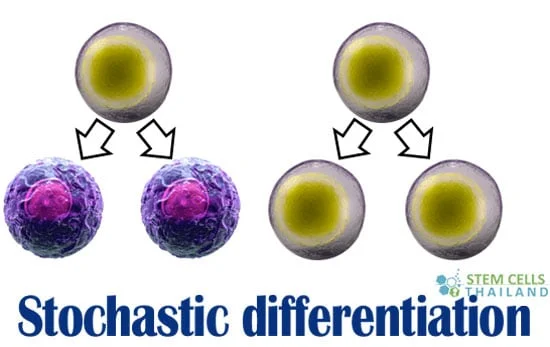
Stochastic differentiation refers to the process in which a stem cell undergoes division, giving rise to two daughter cells that are differentiated.[1]
On the other hand, another stem cell goes through the process of differentiation or mitosis to generate two stem cells that are similar to its original cell state, thereby maintaining stem cell number.[2] This process of differentiation is necessary for stem cells to maintain their number (stem cell reserve) in the body.[3]
Stochastic differentiation refers to the process of cellular differentiation that is influenced by random events, rather than purely deterministic, pre-programmed pathways. In the context of stem cell biology and development, the differentiation of cells can be influenced by a combination of intrinsic and extrinsic factors. While certain differentiation pathways are deterministic and driven by specific molecular cues, stochastic events can introduce variability into these processes.
When one father stem cell divides into 2 differentiated daughter cells. a second father cell divides into two stem cells to maintain the population.
In stem cell populations, stochastic differentiation can lead to diverse cell fates even within a seemingly homogenous population. For instance, a population of identical stem cells might differentiate into multiple cell types due to stochastic events, leading to a heterogeneous mixture of differentiated cells.
While many cellular differentiation events are deterministic and follow well-defined pathways, stochasticity introduces an element of randomness. Recognizing and understanding the role of stochastic differentiation is essential for various fields, from developmental biology to medicine.
[1] ^ Hayashi, Shin-Ichi, Akihiko Murata, Kazuki Okuyama, Yuhki Shimoda, Mari Hikosaka, Hisataka Yasuda, and Miya Yoshino. 2012. Stochastic differentiation into an osteoclast lineage from cloned macrophage-like cells. Biochemical and biophysical research communications, no. 2 (October 22). doi:10.1016/j.bbrc.2012.10.052. https://www.ncbi.nlm.nih.gov/pubmed/23085228.
[2] ^ Sturrock, Marc, Andreas Hellander, Anastasios Matzavinos, and Mark A J Chaplain. 2013. Spatial stochastic modelling of the Hes1 gene regulatory network: intrinsic noise can explain heterogeneity in embryonic stem cell differentiation. Journal of the Royal Society, Interface, no. 80 (January 16). doi:10.1098/rsif.2012.0988. https://www.ncbi.nlm.nih.gov/pubmed/23325756.
[3] ^ Tarlinton, David. 2012. B-cell differentiation: instructive one day, stochastic the next. Current biology : CB, no. 7 ( 10). doi:10.1016/j.cub.2012.02.045. https://www.ncbi.nlm.nih.gov/pubmed/22497941.
Chimeric antigen receptor-T cell treatment (CAR-T cell therapy) holds immense potential to revolutionize organ transplantation, particularly for patients who struggle… Read More
In the ever-evolving landscape of nutrition science, the discourse around dietary fats has undergone significant transformation. The Regeneration Center is… Read More
New research shows that specific types of brain cells become active after brain injuries and exhibit properties similar to those… Read More
Chemokines, critical components in the immune system, are small proteins that facilitate the migration and positioning of immune cells throughout… Read More
Stem cell research examines everything from gene expression to differentiation capacities to therapeutic potentials. With such diverse data types and… Read More
Stem cell therapy has emerged as a revolutionary new treatment approach for neurological and spinal disorders. One up-and-coming method of… Read More